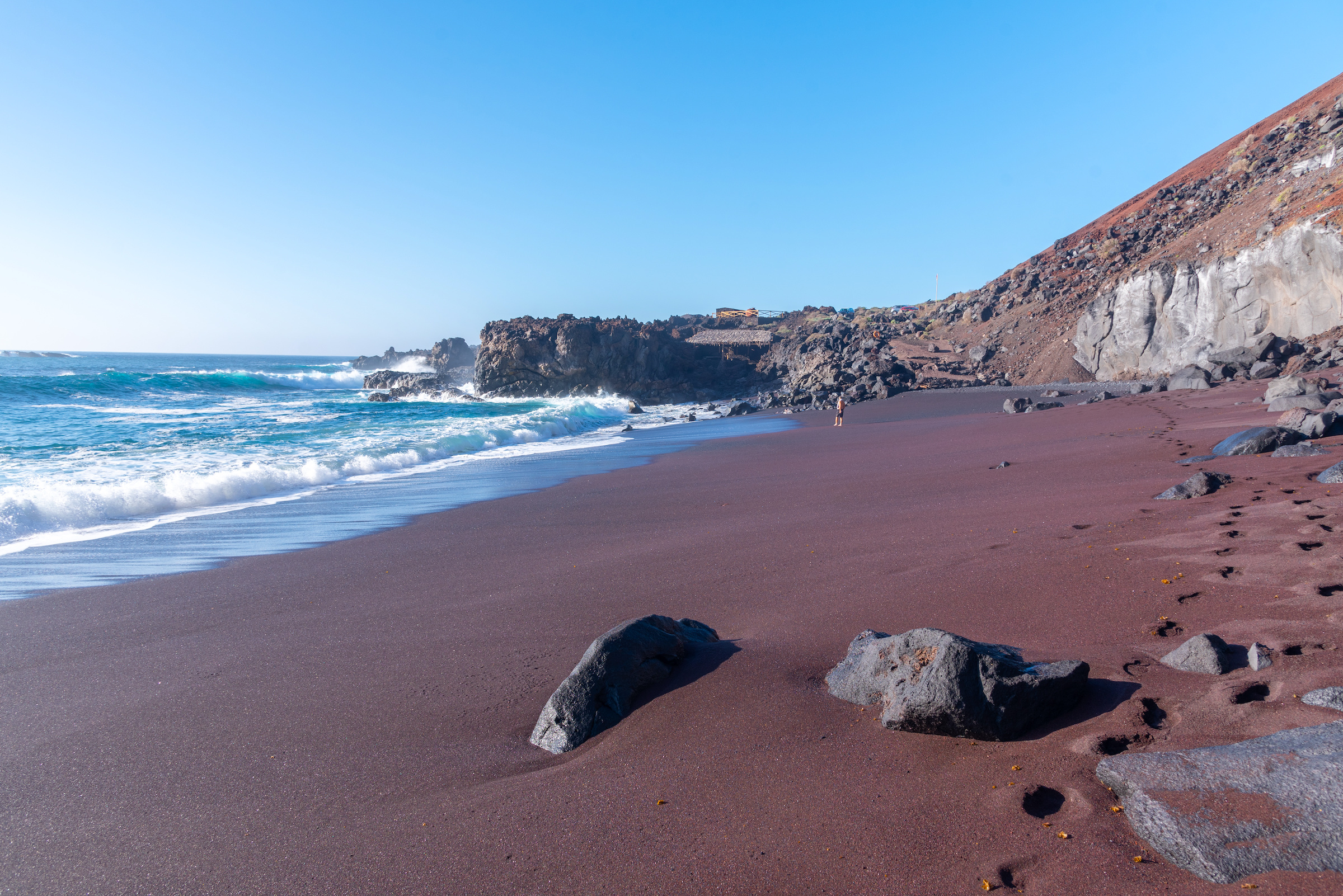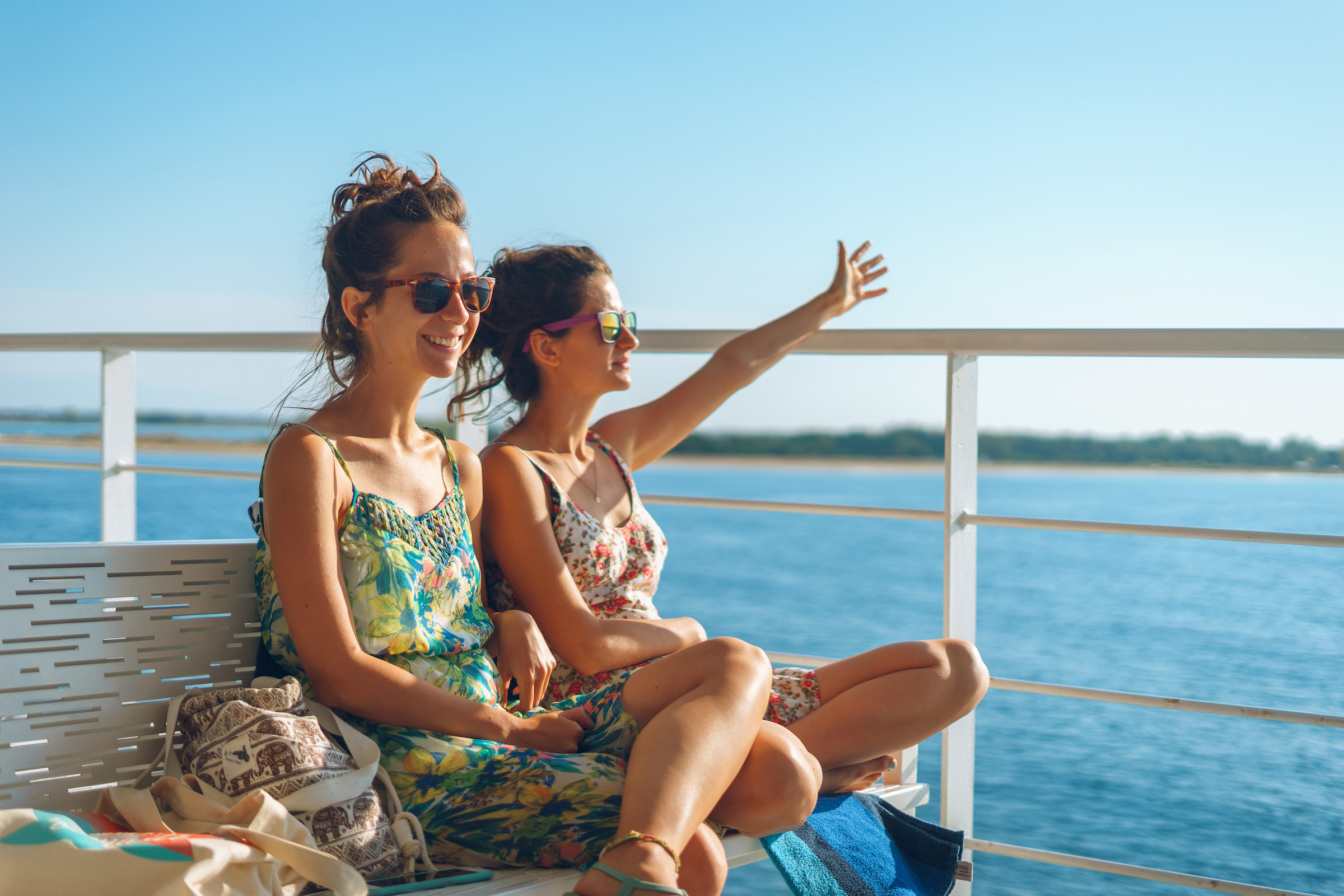A fresh breeze after a shaky landing
Only smaller planes of domestic companies can land at the small airport in the coastal area of Llano de los Cangrejos in the northeast of the island and near the capital Valverde. Now and then it's a pretty shaky affair, but even the first glimpse out the plane's window whets the appetite for more. Namely, to an island that presents itself like a botanical garden in the Atlantic Ocean and where especially individualists feel very comfortable. Those who come from the big city and still have the exhaust fumes of the automobiles in their noses will be haunted by opposite sensations on El Hierro. Because here the air is clear and sparkling like a glass of champagne. The climatic conditions in this part of the Canary archipelago vary between subtropical and fresh.
A striking church tower on a lava cone
A church in white and red is something like the symbol of El Hierro: The Iglesia de la Virgen de la Candelaria. Its bell tower was built on a lava cone, and from up there it looks down on the town of La Frontera, where the actual church is located. The tower marks one of the most striking scenic spots on El Hierro, because behind it a rock wall rises to a height of over a thousand meters. The church is dedicated to the patron saint of the community and dates back to the late 17th century. In the past, the bell of the tower is said to have been connected to all parts of La Frontera by a system of cords. Thus, it invited all the faithful on feast days and fiestas.
Respect and attention for a fragile nature
The inhabitants of El Hierro can only smile wearily when they are called "El culo del archipíelago" by the rest of the Canary Islands. This means "the butt of the archipelago". But: it is a "beautiful butt", and the people who live on this island have always treated the fragile nature around them with great respect and never failing attention. However, this has never been an easy life in any century, and quite a few inhabitants of El Hierro emigrated to Venezuela or Cuba a hundred years ago, hoping for better living conditions for themselves and for their families. Some returned wealthy, others stayed their whole lives on the other side of the Atlantic. In the Middle Ages, they even defended themselves against invading pirates by luring them into the misty mountains, where the uninvited intruders almost always got lost.
Sheep breeding and cheese making by hand
The small island is ideal for hiking, but if you want to go around it on horseback, it will take you just three days. Paths and trails can only be found on the coastal sections, because in the center of El Hierro the numerous extinct volcanoes are hardly passable. The highest peak there is Malpaso at about 1,500 meters. The ten thousand inhabitants have opened up to tourism only hesitantly and with limited success, and there are hardly more than 1,500 guest beds on the island. So, on the poor soils of the homeland, they are mainly occupied with sheep breeding and with a cheese that is made by hand and even exported.
A fountain of health with sulfurous water
It's the same in the quiet villages west of the capital - in Guarazoca and Mocanal. Vines grow on the slopes of Sabinosa, and from there it is not far to Pozo de la Salud. It is called a "health resort" because sulfurous water has been dripping from a well there for centuries. It is said to have healing powers. Through a pine forest, the road leads to El Pinar, home to traditional handicrafts and where almond trees blossom in early spring.
La Restinga - launching point for deep-sea sailors
El Hierro was declared a Biosphere Reserve some time ago in its entirety. This has given a small boost to tourism, but the big breakthrough is still waiting. Farmers are busy growing avocados and, of course, bananas in their small plantations, but general poverty has remained with the people of El Hierro. And this has been the case since the times when the international trading companies refrained from sending ships to this westernmost island of the Canary Islands. Nevertheless, the tiny fishing port of La Restinga has made a name for itself as a launching point for sailors wishing to sail to distant destinations beyond the Atlantic Ocean. La Restinga has the most hotels, and those who stay here are either divers or waiting for the chance to be taken by one of the fishing boats.
A marine protected zone off the coast
Despite the rather faltering start of tourism, El Hierro will probably continue to depend on subsidies from the Spanish capital Madrid and from Brussels for a while. Some planned projects still exist on paper. But something has already changed on this island. For example, the marine protection zone near La Restinga, which is called "Reserva Marina" and states that fishing on the southwestern coast of El Hierro is restricted. Also diving courses are no longer offered in this area to protect the underwater world. Gradually the fish population close to the coast is recovering. Whoever spends his vacation on this island should - if he likes it - try the delicious aromatic honey. It is a bit more expensive than on other islands, but it is worth every penny.
Even on the lava fields plants bloom
But the capital of El Hierro is and remains the wonderful nature. Whoever travels there on the winding roads rarely encounters a car. Extensive juniper groves spread out to the left and right of the roads, and the pine forests give the impression that the hand of a forester has very rarely straightened anything here. This is a natural landscape under a blue sky - provided the humid wall of fog has receded. Beyond the tree line a karstic lunar landscape spreads out, but even on the wide lava fields the visitor discovers one or the other flowering little plant. Those who live on El Hierro strive to preserve all this for posterity.
"Punta Grande" - the smallest hotel in the world
And if you have come to El Hierro to enjoy not only nature, but hospitality and gastronomy, you should stop by the romantic hotel "Punta Grande". If you believe the Guinness Book of Records, this is the smallest hotel in the world. It has only four rooms and resembles a rustic ship's hull from the outside. The former country house, which was renovated one day, is virtually eye to eye with the ocean. It is surrounded by the sea, and those who sit on a stool at the small bar for a sundowner have secured themselves a kind of box seat. At least acoustically, the nearby sea is always present. Also at the evening dinner, when the Vino Frontera is served. This is a white wine that is pressed in barrels made from the wood of pine trees and has a mild yet spicy character.
At the "Punta de Orchilla" once lay the zero meridian
Anyone who looks out at the bar of the "Punta Grande" to the surging sea, understands that there is nothing out there for a very long distance. Not an island and only rarely a ship. And somewhere beyond the horizon lies America. The surf foams wildly at the westernmost point of the Canary Islands. It is called "Punta de Orchilla" and it enjoys the neighborhood of a lighthouse. Only the locals know that exactly here was the zero meridian until 1884, before it was moved to Greenwich. A little further on is Pozo de las Calcosas, and it is amazing that this ghost village can still be found on maps of El Hierro. It is said that the last volcanic eruption on the island took place here in 1793. Today, only the roosters are still crowing there. Somehow this also belongs to El Hierro, the rock in the surf of the Atlantic.


